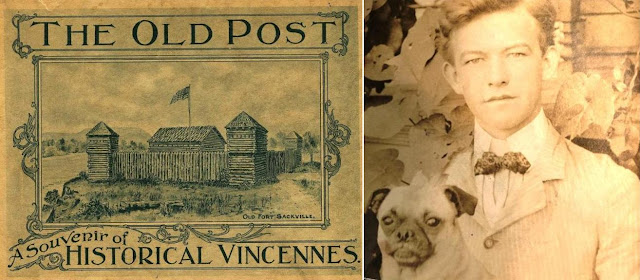The Knox County Public Library recently digitized its historical newspaper collection. As a result, the authors found some fascinating new stories on World War I cinematographer Albert K. Dawson from Vincennes, who was nicknamed "The Boy from Indiana", including a report on how he invented a German grandmother while covering the war in Europe with his movie camera.
 |
Albert K. Dawson, photograph from the family collection, taken around 1903. Left: Dawson's first picture book The Old Post on historical Vincennes.
|
Born in Vincennes, Indiana, Albert K. Dawson (1885-1967) was one of the most enterprising cameramen of the First World War. Shortly after the outbreak of the Great War he went to Europe and filmed with the German army on the Western Front. In the summer of 1915 he joined the Austro-Hungarian forces during the attack on Russian Poland. He later covered the Bulgarian army in the Balkans. Dawson's movies were released in the United States by the American Correspondent Film Company.
Family History
The local press clippings that we found shed new light on Dawson's family background. As described in more detail in our book
Shooting the Great War: Albert Dawson and the American Correspondent Film Company (2013), Dawson's life was heavily influenced by his father Thomas who shared his son's interest in traveling. Thomas was a Civil War veteran who had been involved in 16 battles including Sherman's march through Georgia. Thomas passed away unexpectedly in 1912, when his son Albert was on a cruise in the Caribbean for the Hamburg-America Line. At the time Albert was working as a ship's photographer for this German company. Here is a
download link to an obituary of Albert's father, as well as his mother Lida who passed away in 1923.
 |
Rose Schultheis-Dawson, photographed by her brother Albert for the cover of The Country Gentleman (April 1917). Courtesy Ben Walter
|
Albert also was very much fond of his sister, Rose. Like her older brother, Rose had a strong interest in history and literature, and later in her life she published on the history of her hometown Vincennes. Here is a
newspaper story on Rose's marriage to Leo Schultheis in June 1915, at about the same time when Albert was filming the First World War on the Eastern Front. In addition,
this story in the Knox County Public Library archives reveals how Rose, together with her husband and her mother, went to Terre Haute, Indiana, to see Albert on film in September 1915, when his war movie
The Battle and Fall of Przemyśl was first shown on screen. They must have been impressed to see him on film, reporting at the front on the war in far away Europe.
 |
Albert (right) and his younger brother Charlie, dressed as Civil War soldiers, around 1890. Source: www.ancestry.com
|
 |
Graves of Dawson's father, mother and sister. Vincennes, IndianaGrave of Albert Dawson and his wife Clara Hawkey. Poughkeepsie, NY
|
First Photographic Work
Apart from inside family information the newspaper articles contain stories on Albert's local career as a photographer. The earliest references date from 1905 when he published a picture book on the history of Vincennes -
The Old Post. This
newspaper article has more on Dawson's photo book. Also in the same year 1905, Albert published
this advertisement in the local papers, offering his services as a photographer for the upcoming Thanksgiving. The press reports indicate Albert freelanced as a press photographer for the Vincennes newspapers throughout 1906, as is shown in
this newspaper story on a criminal investigation by the local police. In 1907 he left Vincennes and started working for the photographic agency of Underwood & Underwood in New York City.
 |
The Dawson family on New Year's Day, 1902. From left to right: Charles, Lida, Albert, Thomas and Rose. Courtesy family collection, Lida Joice and Rose Ann Walter
|
Return to Vincennes, 1916
When Dawson came back to the USA in the spring of 1916, having covered the European War on several fronts and military campaigns, his hometown Vincennes had not forgotten about him. On the contrary, by then he had become well-known as a result of his appearances in several war movies that were shown in the United States. His latest film The Fighting Germans had just been released by the Mutual Film Company in May 1916 and it was also shown in the Princess Theater in Vincennes, Indiana, with numerous ads running in the local newspapers, announcing this war film that had been shot by their "local boy" Albert K. Dawson.
 |
Advertisement Vincennes Commercial, 27 May 1916
|
In the summer of 1916, after having been abroad for two years, Dawson returned to Vincennes. He lectured on his experiences as a war photographer for the local Rotary -
here is a press article - but the most interesting report comes from the
Vincennes Western Sun on a lecture that he gave at Lincoln High School on July 28, 1916. The
Sun had arranged an exclusive interview with Dawson and ran a remarkable story that day on his work as a film correspondent during World War I. In this interview Dawson proved himself right when predicting most of the upcoming battles of the Great War. Although he did not think the Central Powers would lose the war Dawson did expect a continuing stalemate on the Western Front, which would especially benefit the Germans. His admiration for the German talent of organization shines through in this article, but Dawson did emphasize he was first and foremost pro-American.
 |
Albert Dawson, correspondent, at his desk in a war zone cottage (1915). Source: National Archives, Washington, D.C., 165-WW-418P-096 |












